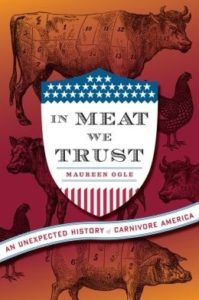 I do this every time, don’t I. I start reading a book and then start writing the review before I am a third of the way in. Why can’t I be a good little reviewer – especially when Maureen Ogle was good enough to make sure by email that I would be interested in a review copy of her new book In Meat We Trust. Once I got into the second chapter this morning at the YMCA as six year olds played, I knew I had made the right call even thought the book was about the history of the US meat industry.
I do this every time, don’t I. I start reading a book and then start writing the review before I am a third of the way in. Why can’t I be a good little reviewer – especially when Maureen Ogle was good enough to make sure by email that I would be interested in a review copy of her new book In Meat We Trust. Once I got into the second chapter this morning at the YMCA as six year olds played, I knew I had made the right call even thought the book was about the history of the US meat industry.
See, in the history of brewing in Ontario that Jordan and I are working on, the second half of the 1800s was the only period throughout the 400 years of beer in the colony then Province that was without a pre-existing myth set out for us. You have your explorers and you have your New France. After 1783, you have your Loyalists, then pioneers and the expansion of settlement. Then in the early 1900s you have temperance, then prohibition followed by industrial macro gak with craft following up in the rear. That’s it, right?
Nope. As it turns out the good stuff we know as modernity pretty much occurs between the US Civil War and WW1. Mass communication and transportation. The shift from local to national markets. The vision to view the private marketplace in an imperial way just as Britain and her competitors had as nations for centuries. It’s when things scaled up. From our research, Jordan and I have identified a similar thing. And just as the names Swift and Armour have continued in the US food trade due to decisions made in the 1870s and 1880s, brewing names from Ontario at the time like Labatt and Carling are still known for the same reason.
Maureen shows that the train lines stretching westward across America brought, first, live cattle then chilled carcasses and finally butchered cuts of meat from Chicago to the cities of the US eastern seaboard. The new transportation technology allowed for the best quality finished product to be shipped for the least cost. So, too, with beer. While no one in their right mind loads cart for the pioneer edge of settlement with barrels of beer when whiskey is available, train cars of beer barrels sent by brewers with vision can crush a lot of local old school brewer hundreds of miles away. It’s so… modern.
No wonder the peak number of breweries was in the 1880s and not just before prohibition. Incorporations and collusions were just the thing for late Victorian brewing magnates with facilities located on railway spurs to ensure the beer and money flowed. And as with big brewing so too big butchery in the last years of the 1900s. I will keep reading In Meat We Trust to find out what happens next. You should be, too.
